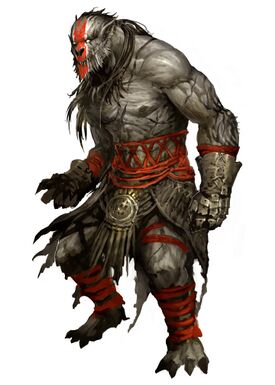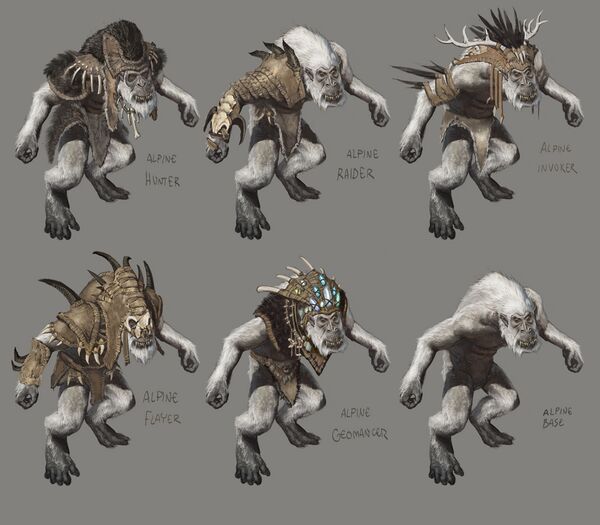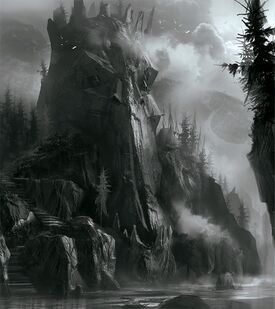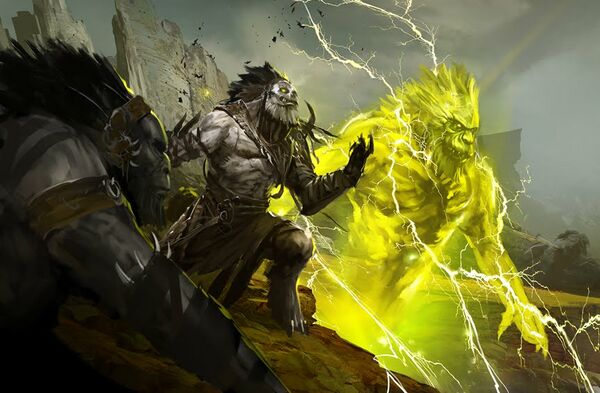Planet of the Grawl
Planet of the Grawl is a tale by Jeff Grubb.
Text[edit]
Of all the races of Tyria, the apelike grawl are the most underappreciated and underestimated. A race of furry simian bipeds, the grawl can speak and use tools and weapons. They even have a fair approximation of clothing, but they lack most of the trappings of advanced society. They make their homes in caves on the edge of civilization and are considered a lesser race of raiders and bandits by the more developed cultures around them. While many grawl do resort to banditry, just as many seek nothing more than to be left alone.
Biology and Society
“"We are the meek, we are the humble. We watch and we wait for others to stumble"
— Traditional grawl saying
Grawl are humanoid ape-like creatures—slightly larger than the typical human—and are covered with long fur of various shades of grey. Because their faces and postures are definitely simian, charr scholars have theorized that the grawl are a debased form of human, or that the humans are a type of grawl uplifted by their gods.
Human researchers, on the other hand, point out the heavy, hunched shoulders of the grawl and the fact that they walk on their toes—both features of the charr—and posit a close kinship between the charr and the primitive grawl. Unlike the charr, however, the grawl run with a bounding, skipping gait that gives them sufficient altitude to see their targets at a distance, and they move with a sure-footed grace that gives them an advantage in their rocky territory.
Grawl live in small tribes consisting of several families, usually under the command of one or more shamans. These shamans are responsible for both the spiritual and daily life of their family unit. They wield magical powers that help protect their flock and enforce the will of their gods.
Grawl tend to subsist as hunter-gatherers, though they often rely on scavenging. They do not plant fields, and although they herd animals, they do not otherwise domesticate them. They have no architecture, using only natural caverns as their homes. These subterranean dwellings are decorated with cave paintings, netted frames of wood, and strings of stolen glass balls and other scavenged baubles.
Clothing and Equipment
Grawl have some level of proficiency in leatherworking and are able to fashion primitive metal weapons and tools. While they are comfortable in little more than a loincloth, grawl warriors conduct raids bedecked in heavy leather armors with protective hoods. As symbols of their office, grawl shamans wear colorful headdresses and necklaces made with the feathers of rare birds or bones harvested from their enemies.
Grawl weapons are usually poorly-crafted imitations of the weapons used by norn, humans, and charr. They use scythe-like axes made of dark metal forged in campfires, and craft bows to bring down prey at long range. Grawl are not discriminating; they will often use weapons and equipment stolen from other races and repurposed to their own needs.
History
“"Fire warms, but fire also burns. The gods keep us safe, but sometimes they destroy. We kill...or we are killed. This ends the lesson."
— Krippus, grawl raider
The grawl are native to Tyria, and Ascalon in particular. The earliest mention of them is found in early charr military tributes that predate the arrival of humans in the area. In these annals, the charr are always portrayed as victors with the defeated grawl pulling the charr commanders in great chariots. The charr dominated the grawl, forcing them into the Shiverpeak and Blazeridge Mountains and beyond, where they lived at a subsistence level.
Dispersed and powerless, the grawl survived as raiders in the human kingdom of Ascalon and elsewhere. When the charr returned under the Flame Legion, they successfully enlisted (and in many cases enslaved) many of the local grawl as militia. The grawl proved to be unmanageable beyond a squad level, however, and were used primarily as scouts.
Since the conquest of Ascalon, the grawl have returned to their meager existence at the edges of civilization. Few races have the need or interest to interact with the grawl, whose lack of respect for personal property and untrustworthy behavior makes any dealings difficult. A number of individuals of many races have looked upon the grawl as potential allies, cheap labor, or easy marks. All have been disappointed in the results.
The grawl today exist much as they did hundreds of years ago—superstitious cave dwellers whose only interest in the outside world consists of slaying those who wander into their territories or pose an affront to their gods.
Matters of Faith
“I am one of the faithful. YOU are mistaken in your beliefs. THEY are all godless heretics.
— Thockalock, grawl shaman
Grawl are bound together by faith, but separated by it as well. They are a deeply religious, shamanistic people, but their particular brand of animism creates numerous localized factions that are mutually intolerant of each other.
In a nutshell, the grawl believe that particularly important places, individuals, and items are imbued with great spiritual force. This differs from the animist beliefs of the norn, who hold that the Spirits of the Wild are imbued in all of its children (i.e., Bear is present in all bears). The grawl version of animism professes that all physical things contain spirits, and that particularly powerful or unusual beings and items hold spirits capable of granting miracles, and are therefore worthy of veneration (e.g., that particular bear is powerful—we should worship it). By enhancing the power of a given item, location, or being, grawl hope to curry its favor and protection.
As a result, grawl tend to worship a wide variety of items, ranging from natural features to unusual phenomena to powerful creatures. One tribe of grawl may bring offerings to a rock feature that looks like a grawl's face (like the one on the right), while another may revere a great swamp beast and sacrifice travelers to it in order to save themselves. The depth and sincerity of their worship tends to pit rival grawl tribes against each other, as each believes they have the true religion, and all others are led by false gods.
On occasion, great religious movements form among the grawl, encompassing multiple tribes throughout an entire region. During these transient periods of religious fervor, grawl will abandon their traditional beliefs for the trending new faith. At times like this, the grawl are at their most dangerous, for the religious friction between the new faith and the old can erupt into a bloody holy war—one in which all non-grawl are potential converts, hostages, or enemies.
The superstitious grawl are belittled by other, more advanced races for their xenophobia and the seemingly ridiculous nature of the things they worship. Humans and asura tend to be the most dismissive of grawl beliefs, while the norn are more sympathetic, feeling the grawl have simply missed the large point of the Spirits of the Wild. The charr, who historically have oppressed the grawl, are the most emphatic in trying to cure them of their belief system, as their superstitions make the grawl easy prey for manipulative agencies such as the Flame Legion. However, many charr draw a parallel between grawl animism and human religion, to the irritation to both grawl and humans.
Behind the Scenes
When the grawl first appeared in an alpha test version of Guild Wars Prophecies, they were called trogs. This old nomenclature survived deep in the heart of wikis devoted to the subject, and in Guild Wars 2 names like "Grawl Udolyte"—a name which makes more sense when you consider it was originally "Trog Udolyte," or "troglodyte." A troglodyte is traditionally a cave-dweller, and though Dungeons & Dragons transformed them into stinky lizard-guys in the mind of role-playing gamers, the traditional image and odor of the primitive Neanderthal hang heavily over the grawl.
The grawl in the original Guild Wars were primarily spawned as general-purpose bad guys, and they are absent from most of the major quests. They were overshadowed by the charr and undervalued by all. Of all the races in Tyria, the grawl are the most left behind in Guild Wars 2, still firmly ensconced in their past. Not all species got a chance to advance technologically in the 250 years between our games, and the dispersed, primitive grawl were good candidates to remain the same as they were in Prophecies—for better and for worse.
Trivia[edit]
- The name is a reference to the novel Planet of the Apes.
External links[edit]
- Planet of the Grawl, ArenaNet blog (Archived)




